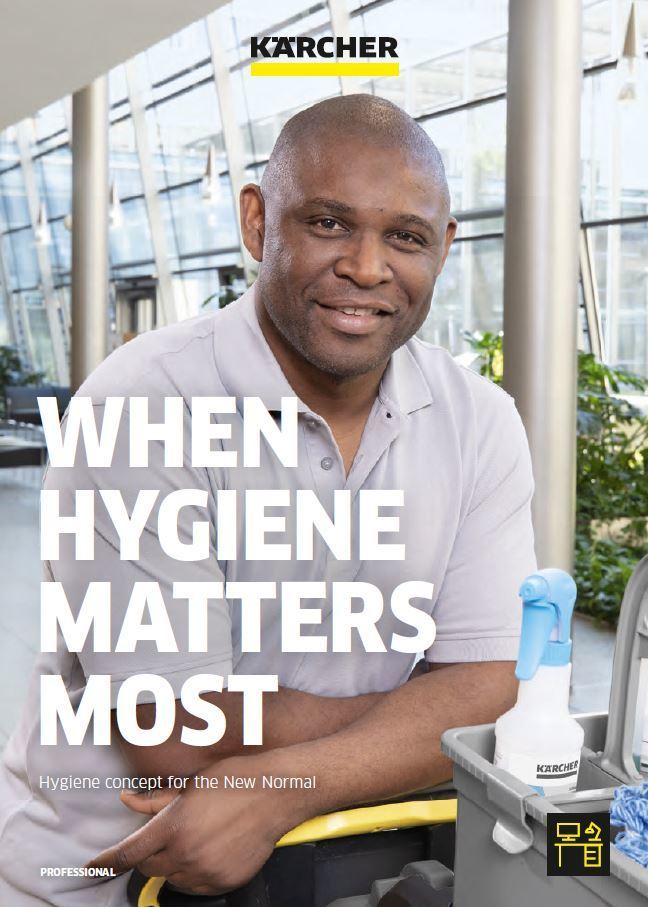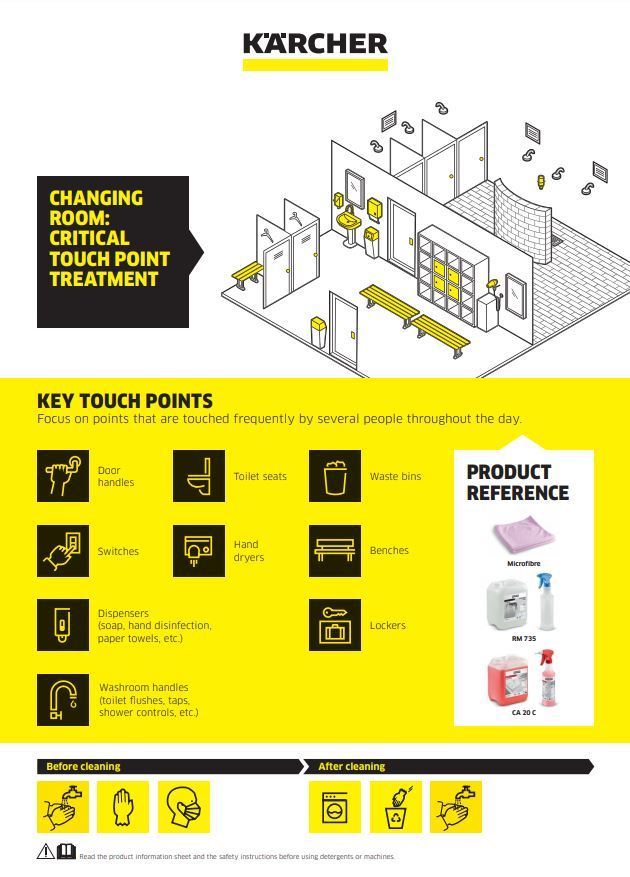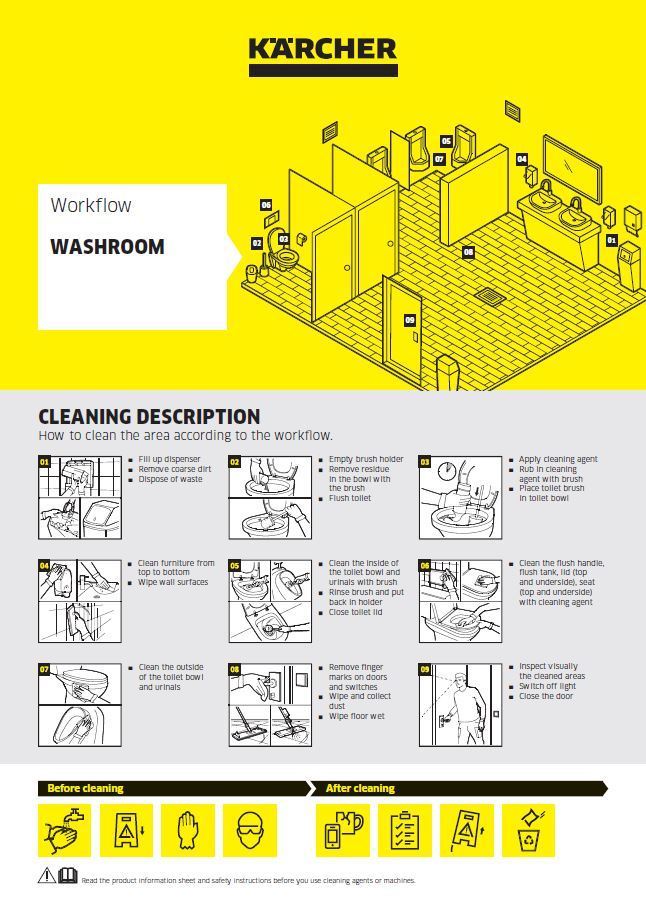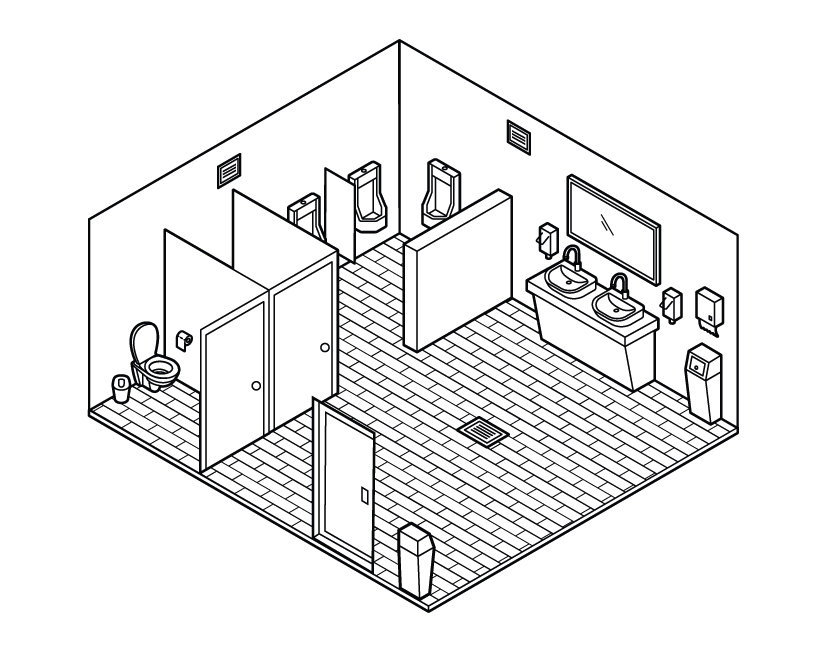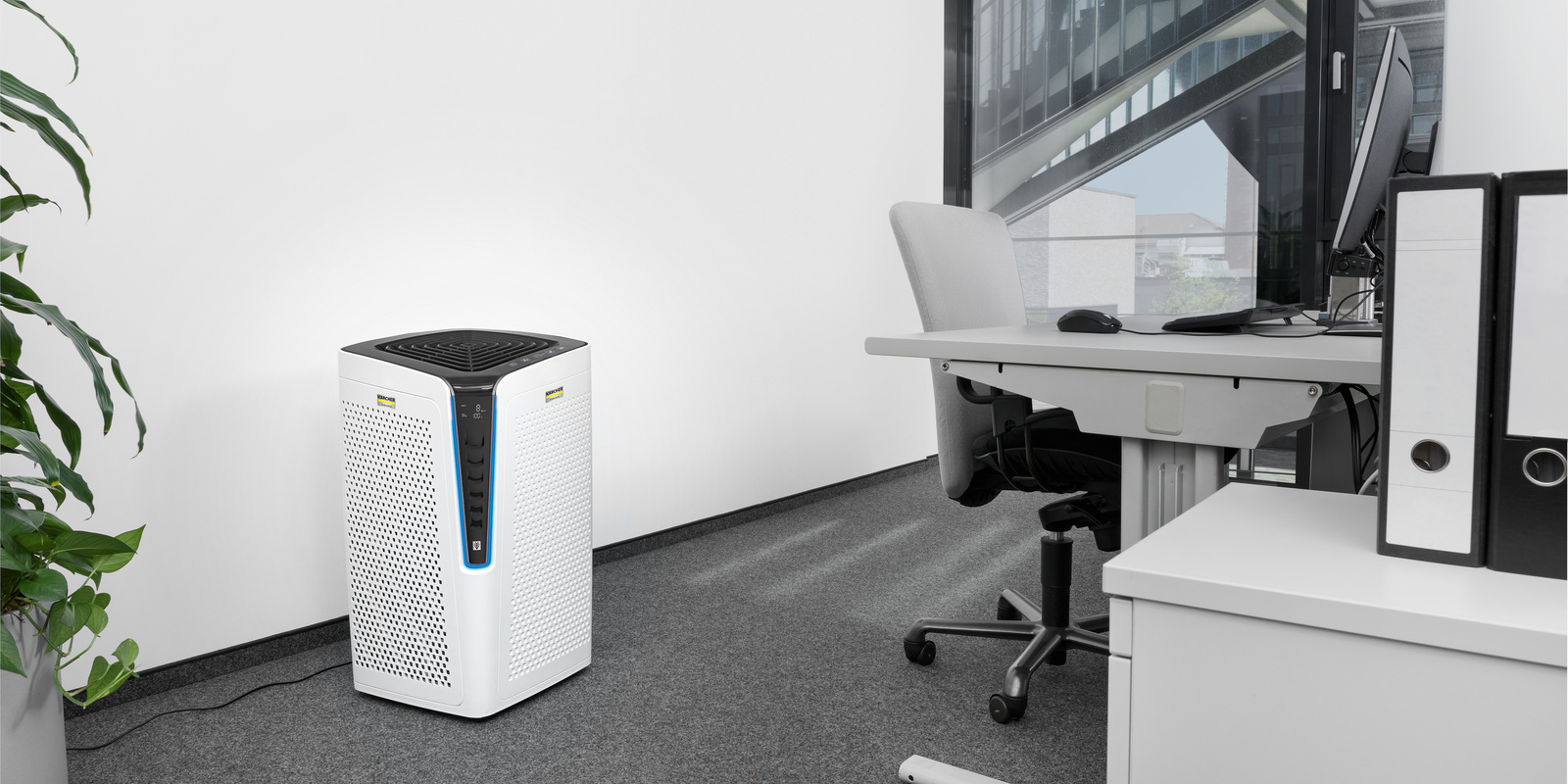Hygiene solutions for your facility/business
Discover our solutions for your facility and how we can help you ensure hygiene safety through our comprehensive training and support materials.

Office buildings

Education facilities

Retail

Restaurants and catering

Public transport

Hospitality
Critical challenges in the "new normal"
The pandemic has disrupted the relationship between people and places and therefore changed priorities within the facility services market.
Recommendations from international health authorities are shaping new hygiene standards: It's all about infection prevention!
Going beyond our products, our knowledge and solutions are reshaping the way you do business.
The five E's set out the essential elements of the new cleaning concepts and standards:
Evaluate, Enhance, Enable, Ensure and Enroll
Kärcher hygiene solutions – expertise that goes beyond products
In offices, schools, healthcare institutions, hotels, restaurants, canteens, retail trade, industry or public services – hygiene is key for a safe environment for tenants and visitors.
Kärcher offers the right solutions for your individual challenges.
Hygiene in office buildings
Hygiene concepts from healthcare institutions are transferred to all kinds of facilities. Recommendations from international health authorities are shaping new hygiene standards: It's now all about infection prevention in facility services. Workplace routines will have shifted by the time everyone can get back to their workplace after lockdowns due to the pandemic.

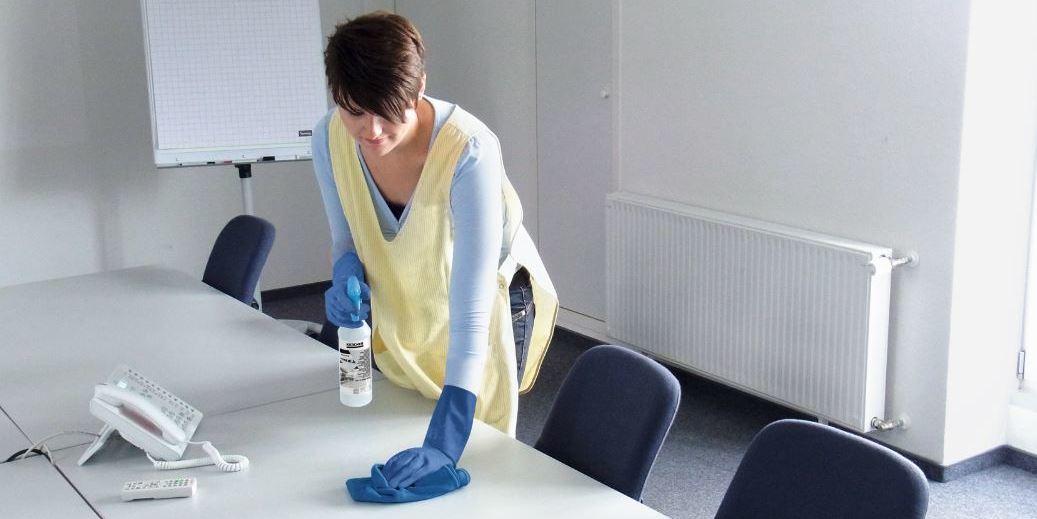

How to create a safe and hygienic environment for tenants and visitors in office buildings
Hygiene and safety will be top concerns as employees return to their workplaces. Companies will need to further minimise the number of surfaces people can touch and make sure that the workplace environment does not permit cross-infection. It is important to protect areas in which people gather and stay for longer periods of time from the spread of germs and viruses. Alongside all recommended personal hygiene measures, there is more that you can do to provide security for tenants and visitors in office buildings
Surface cleaning and disinfection: Critical touch points in office buildings
Hygiene in education facilities
Hygiene and safety will be top concerns for teachers, students, pupils and their parents when schools, universities and other educational facilities re-open. A proper hygiene concept is essential to clean public institutions like schools, universities and childcare facilities effectively. It contains elements such as effectively ventilating rooms or reducing the size of groups present, as well as social distancing and rules for wearing masks. An additional important factor is the implementation of effective cleaning workflows – cleanliness can prevent illnesses if cleaning and hygiene protocols are implemented and followed.



How to create a safe and hygienic environment for people in education facilities
Alongside all recommended personal hygiene measures, there is more that you can do to ensure a safe level of hygiene in your facilities. Recommendations from international and local health authorities are shaping new hygiene standards: It's now all about infection prevention in public buildings.
Daily hygienic cleaning of all surfaces is key to providing a safe environment. The right choice of cleaning equipment and products, plus well-trained staff to implement the new cleaning protocol, can provide the desired level of hygiene. Thorough documentation of this work, as well as training support and video tutorials, ensure continuous focus. Due to the high levels of footfall in schools, universities and childcare facilities, hygiene measures according to the "new normal" need to be implemented during the re-opening phase. Touch points such as door handles, handrails, tables and chairs, as well as sanitary facilities, should be cleaned throughout the day, depending on the actual risk of infection. Floor disinfection is only necessary in sports halls or playrooms, where physical skin contact with the floor is possible. Outside areas, such as playgrounds or seating areas, belonging to a certain facility only need to be sanitised if a confirmed outbreak of an infectious disease has occurred at the facility.
Government guidelines and requirements set out by public authorities regarding hygiene measures in public environments need to be followed.
Surface cleaning and disinfection: Critical touch points in education facilities
Hygiene in retail stores, shops and supermarkets
Customers and employees will expect retail stores, shops and supermarkets to implement extra cleaning measures during a pandemic. Making them aware of what is being done to meet their expectations will inspire confidence and trust. This can be accomplished in different ways, for example by increasing the visibility of cleaning and sanitising tasks in view of customers. Retail brands are responsible for stepping up customer protection in their stores, while the public has higher expectations than ever before. Now is the time to leverage your store cleaning/hygiene specifications in order to ensure that your ongoing measures are as successful as possible and to guarantee the safety of your greatest assets – your employees and day-to-day customers.



How to create a safe and hygienic environment for customers and staff in retail businesses
It is important to protect areas in which people gather to shop and socialise, and confined areas in which people pass each other from the spread of germs of all kinds. Alongside all recommended personal hygiene and social distancing measures, there is more that you can do to provide security for employees and customers in retail stores, shops and supermarkets.
Surface cleaning and disinfection: Critical touch points in retail stores, shops and supermarkets
Hygiene in restaurants and catering facilities
Recommendations from international health authorities are shaping new hygiene standards, especially in areas where people gather to eat, drink and socialise: More than ever, it's all about hygiene and infection prevention in the restaurant and catering business. Workplace routines and customer expectations will have shifted by the time everyone can get back to their workplace after lockdowns due to the pandemic.



How to create a safe and hygienic environment for employees and guests in different restaurant facilities
It is important to protect areas in which people meet, eat and stay for longer periods of time from the spread of all kinds of germs, viruses, bacteria and similar organisms.
Alongside all recommended personal hygiene and social distancing measures, there is more that you can do to provide security for employees and guests in different restaurant facilities.
Surface cleaning and disinfection: Critical touch points in restaurants and catering facilities
Hygiene in public transport
Due to the high footfall on public transport vehicles, complete hygiene safety is not fully achievable. However, travellers will expect improved hygiene measures as cities become denser in population and private traffic is more and more often banned from city centres.
An effective cleaning and hygiene concept with thorough, visible documentation can help to provide the required awareness of risks and build trust in public transportation.



How to create a safe and hygienic environment for passengers and staff on public transport
Hygiene and safety are top concerns for travellers on public transport.
A clean environment is key to establish the required trust in public transportation. Thorough documentation of key touch points and the frequency of their cleaning, visible to travellers, will further improve the image of the hygiene measures taken.
Alongside all recommended personal hygiene measures, there is more that you can do to ensure the safety of passengers and staff.
Surface cleaning and disinfection: Critical touch points on public transportation
Hygiene in different hospitality facilities
Guests are at the heart of your business; as a result, their safety and comfort is a top priority, alongside showing the same great care for associates and staff members of all kinds. During and after the pandemic, visible and trustworthy hygiene and infection prevention is what matters most. Customers and guests expect new routines regarding cleanliness and hygiene and visible proof of the enhanced measures that have been taken.
We offer solutions for this task, including top-performing and economical machines to clean and disinfect your hotel or other hospitality facilities from top to bottom with ease. The machines are as quiet as a whisper and can therefore be used day or night, all while improving the wellbeing of each guest and employee and ensuring your hotel is maintained to the best possible standard.



How to create a safe and hygienic environment for employees, guests and visitors in hotels and other hospitality facilities
It is important to protect areas in which people stay, socialise, work, eat, relax and sleep from the spread of germs and viruses. Alongside all recommended personal hygiene measures, such as social distancing, wearing protective masks and implementing enhanced hand-washing routines, there is more that you can do to ensure safety and hygiene for employees, guests and visitors in your facilities.
Surface cleaning and disinfection: Critical touch points in different hospitality facilities
Tailor-made risk assessment for your property
Assess the hygiene risk in your property
A risk assessment forms the basis for the right solution to ensure infection prevention on site. The extent of the required cleaning and disinfection measures is determined and established on a needs-oriented basis.

